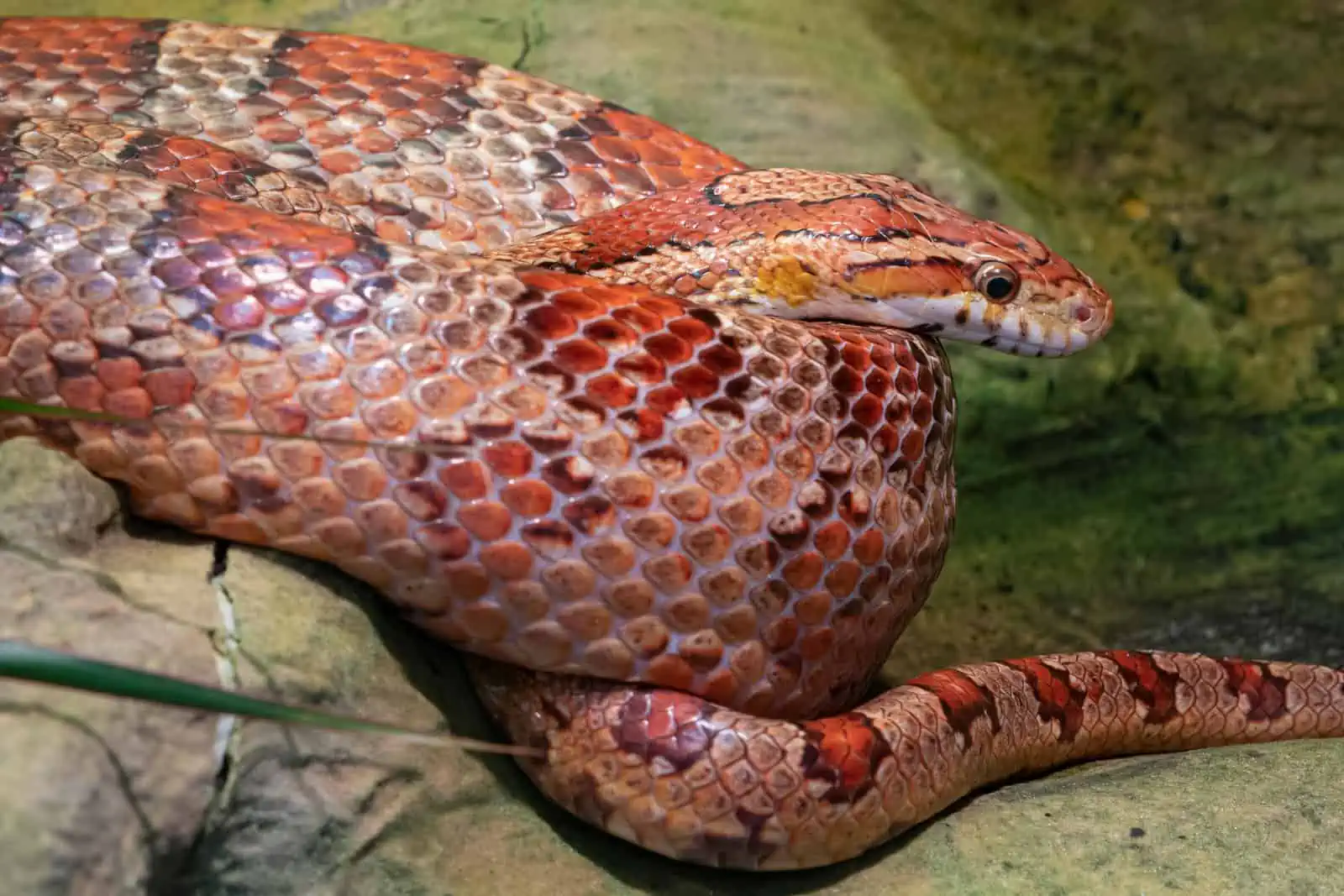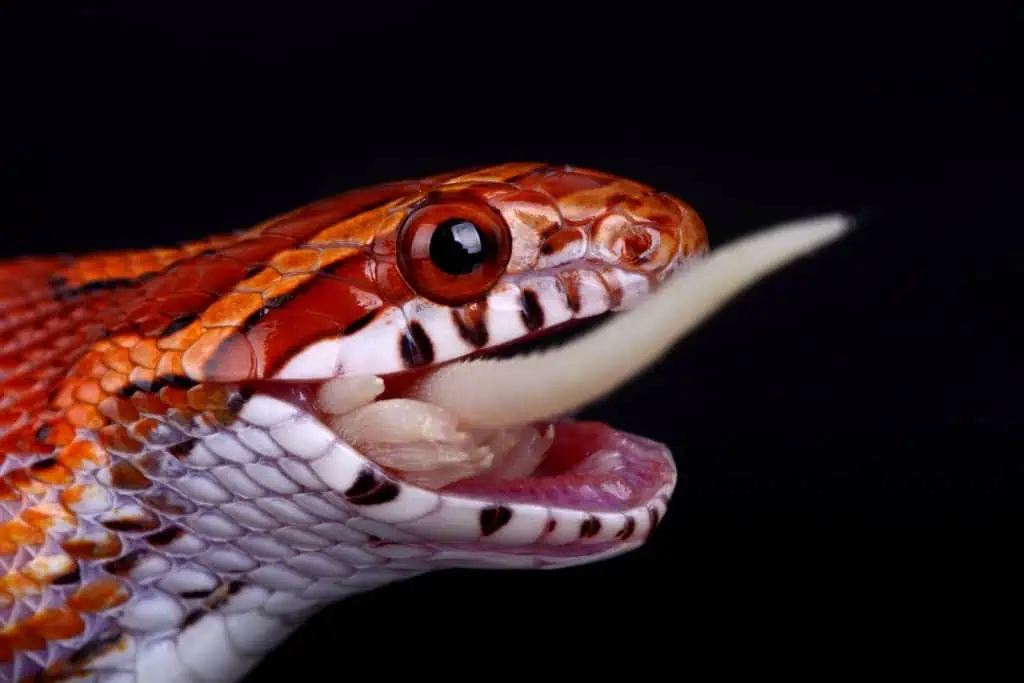The size of a corn snake is one of the most common questions that naive pet parents ask when they first start thinking about getting a pet snake.
Let me tell you – corn snakes definitely pack a punch! You may be surprised to find out that they can get ~ 5-6 feet long.
That’s quite impressive – considering these are one of the smaller species of snake available in pet stores.
The growth rate of a corn snake is quite incredible. With proper care – they can reach their full adult size in as little as two years. They will achieve most of their growth in the first year and then taper off slowly until maturity.
However, there are certain factors that can affect the growth of your lovely pet, like:
- Food
- Temperature & humidity range
- Tank size
- Activity level
- Health condition
- Stress
So, it’s important to make sure they are provided with the best care possible in order for them to reach their full potential.
Without further ado, let’s delve into details of the corn snake’s growth rate and size that can fully be expected.
Corn Snake Size & Growth Chart
Female corn snakes are comparatively longer than male corn snakes. An average corn snake is about 150cm (60 inches).
Their growth starts immediately after hatching but proceeds gradually. They become sexually active after 18-36 months.
They reach up to full size in two to three years (with weight ranging between 1-2 pounds) & remain there for the rest of their lives.
To provide you with a clearer understanding, below I’ve compiled information in tabular form
| Age of Corn Snake | Length of Corn Snake | Weight of Corn Snake |
| Hatching | ~8-12 Inches | 6-8 Grams |
| 6 Months | ~20-30 Inches (1.6-2.5 feet) | 26-30 Grams |
| 12 Months | ~35-40 Inches (~3 feet) | 35-100 Grams |
| 2-3 Years | ~60-72 Inches (5-6 feet) | ~900 Grams |
The corn snake is not the largest species in the United States. The title of largest species goes to the forest-dwelling eastern indigo snake – which can grow ~7-9 feet (84 to 108 inches). Additionally – it is much smaller than the largest tropical snakes found around the world.
🐍 Measuring Tip: To measure your slithery friend – all you have to do is take a string & while handling it – place the string along its body, beginning at the tail. Mark the length & use a measuring tape to check it.
Life Span of Corn Sanke
Male corn snakes live longer than female ones.
You will be amazed to know that as pets – if all their needs are met properly – they can live ~23 years.
The record for the oldest corn snake in captivity was 32 years and 3 months. However, in the wild – they survive only 6-8 years.
What Habitat Size Is Best Suited for a Full-Grown Corn Snake?
Generally speaking, your reptile friend requires a habitat with a perimeter that measures twice its body length. An adult corn snake is 60-72 inches – thus, its habitat must be ~120-140 inches or more. Similarly, right after hatching – it will require a habitat of ~24 inches.
- If you put a juvenile snake in a large adult tank – it might get scared & feel overwhelmed by the empty area. This could cause your scaly friend to search for a hiding spot.
- On the other hand – if the tank is too small, your reptilian best friend might feel confined or unstimulated – which can lead to a desire to escape its habitat.
I suggest pet parents start with a smaller tank suitable for your slithery best friend’s size and gradually increase the size as your snake grows. That way, you can provide it with a safe environment for its development.
A baby corn snake can fit in a ~10-gallon aquarium – for a middle-sized snake, use a ~20-gallon tank; however – an adult corn snake will need a 40-gallon aquarium.
The key thing to remember is the bigger, the better. 😊
Does Shedding Affect a Corn Snake Growth?
Shedding is the natural process of losing skin in reptiles. In Corn snakes – first shedding happens after 7 days of birth. They undergo this process to adjust their body according to increasing size.
Unlike mammals – whose skin stretches when their body expands, your corn snake’s skin stays the same size. It won’t change even if their size increases – so they require more skin.
Moreover – shedding removes harmful parasites from the body. Shedding is instrumental to its health, growth, and life expectancy.
| Corns Snake’s Age | Shedding Time |
| Baby Corn Snake | Every 4-5 Weeks |
| Adult Corn Snake | Every 5-8 weeks |
If you’ve got a baby or juvenile corn snake, they will typically shed their skin twice as often as an adult. That’s because they’re growing rapidly and need to replace their skin at a rapid pace too. On the other hand, adults usually only molt four to six times a year.
So keep that in mind – your pet’s shedding habits will slow down further as they get old.
What Other Factors Affect Corn Snake’s Total Growth?
Understanding what affects a corn snake’s growth rate and overall quality is important. Here I’ve outlined important things to keep in mind:
Temperature Fluctuations
Temperature is a tricky yet major factor in the growth of corn snakes. All snakes rely on their surroundings to keep warm! They require both cold and warm sections in their enclosure.
If the temperature isn’t ideal, your corn snake may struggle. This means they’ll end up using extra energy just to maintain their body temp – leaving them with not enough energy to grow as quickly as they’d like.
In the chilly environment, your corn snake won’t have an appetite as they need heat to process their meals. Not having nutrition can decrease growth rate if it’s cold for a lengthy period of time.
To avoid this, you’d use a heat lamp to keep the temperature steady and let your snake easily maintain its body temperature.
Habitat Size
The tank should be spacious enough for snakes to move freely; if small, their growth will cease. And it’s important to keep only one snake per tank.
As I mentioned earlier, a big tank can make your force your baby pet to stay hidden, so lack of movement & stretching can also hinder its growth.
Humidity
To keep your corn snake healthy and fully functional, humidity should range between 50-70%.
Humidity plays an important role in the shedding of your scaly companion as it provides enough moisture for a safe & easy shed every time.
If you go too far in either direction, your snake will likely suffer.
- Keeping the habitat drier than recommended can cause trouble with shedding.
- Whereas a wetter-than-ideal environment could lead to bacterial & fungal infections.
You can increase the humidity level in your scaly buddy’s habitat in various ways, such as:
- Use a substrate that retains water & water it regularly.
- One solution is to use a bigger water container.
- Regularly misting the habitat is also an option.
- Another helpful approach is to give your reptile buddy a damp hiding spot.
You can check your pet’s tank’s humidity level using a hygrometer.
Diet
It’s important for you to make sure that mice are the primary source of nutrition for your corn snake. Feeding them other things instead could result in stunted growth & poor health over time.
So – ensure they get their main diet of mice – it’ll help them reach their full potential! For your corn snake – aim for a mouse the same thickness as its midsection.
Feed your slithery buddy frozen rodents like mice every 10 to 14 days if they’re an adult – and more often if they’re younger.
Activity
Providing your scaly friend with plenty of opportunities to move around is essential for them to reach their full growth potential. This means they need different things in the tank, such as:
- Enough space;
- Proper substrates;
- Variety of hides & climbing objects
An inadequate level of activity can lead to an unhealthy or sedentary lifestyle, which could cause long-term issues with growth and development for your reptile pet.
Health Conditions
It’s important to keep an eye out for any health problems your scaly pet may have. These can range from skin conditions to respiratory issues & they can all affect your corn snake’s growth rate if untreated or left unchecked.
Visiting your vet frequently – as they’ll be able to detect any potential health issues early on and provide treatment.
Stress
Unnecessary stress due to overcrowding, loud noises, or sudden movements can also hinder your reptilian best friend’s growth. If a stressful situation arises, it’s important to act as quickly as possible and reduce the stimuli.
This could be done by providing a secure hiding spot where your scaly pet feels safe from any potential danger & can relax away from the noise.
How Can You Ensure a Corn Snake Reaches Its Full Growth?
Caring for your beloved pet properly will ensure it reaches its full length of five to six feet with ease.
- Feed your buddy a frozen mouse or rat according to their schedule – it’s the most important factor in the growth of a young one.
- Make sure the home of your scaly best friend is suitable for their growth – set the right humidity and temperature – usually between 70-90 degrees Fahrenheit – in order for them to thrive.
- Provide your snake with plenty of places to hide, climb & explore.
- Handle your snake with care – as they can be easily stressed by too much handling or interaction.
- Lastly – tackle your scaly companion’s growth with the growth chart & take your pet to a vet regularly for checkups, including fecal tests & blood work – this will help detect any hidden problems that could affect your buddy’s growth.
Corn snakes grow gradually – if you do not observe any noticeable growth – have patience because it takes 3 years to reach its maximum size.
👉 Important Note: A 4-foot-long corn snake doesn’t always mean there’s an issue with its growth. Genes also play a significant role in its size. To ensure your slithery best friend grows as big as it can – take good care of it during its juvenile stage in terms of nutrition & habitat conditions. 🙂
Take Care!
Well, there you have it – now you know all about corn snake size & growth.
Whether you choose to keep a baby corn snake or an adult one – you should do your research & familiarize yourself with its needs so that it stays healthy & happy!
As corn snakes age – their growth rate slows down – but some specimens can potentially reach over 6 feet in length – If cared for properly.
How big is your corn snake? – Are they still growing? – Do you have any tips or advice for other owners of corn snakes on how to properly care for & look after them, even as they get bigger? We’d love to hear your thoughts & experiences!




